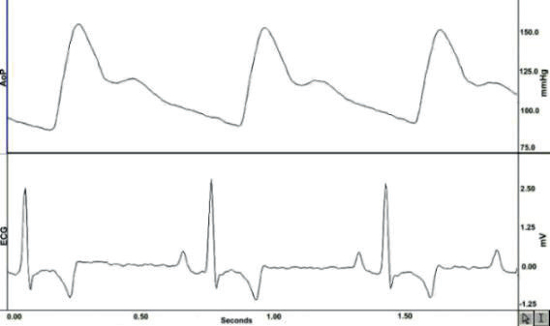Effects of Various Preanesthetics on Left Ventricular Mechanics, ECG, Systemic Arterial Pressures, and Degree of Sedation in Healthy Dogs
Introduction
Preanesthetics compounds are used commonly in clinical medicine prior to induction of anaesthesia and sedation of uncooperative dogs during routine physical, electrocardiographic and echocardiographic examinations.
Objectives
The objective of this study was to compare the cardiovascular effects of 4 preanesthetic compounds - when given alone - on cardiovascular function.
Methods
Four healthy Beagle dogs - instrumented to telemetry for ECG and systemic arterial pressures - were randomly given vehicle (saline), 0.2 mg/kg acepromazine, 0.01 mg/kg buprenorphine, 0.5 mg/kg butorphanol and 1 mg/kg morphine, intravenously. Left-ventricular stroke volume (SV) was estimated by echocardiography. Tranquilization degree, heart rate (HR), QTc (Fridericia), aortic mean pressure (AMP), pulse pressure (PP) and aortic stiffness (AS = PP/SV) were obtained in the groups for 6 hours.
Results
Acepromazine produced the greatest decrease in AMP (p < 0.001) and degree of tranquilization for the longest time. Butorphanol and morphine also decreased AMP (p < 0.05). HR was decreased by acepromazine (p = 0.001) and buprenorphine (p < 0.01), butorphanol (p < 0.01) and morphine (p < 0.05) at the 1st hour. PP was decreased by acepromazine. AS and QTc did not change among the groups.
Conclusion
A level of tranquility suitable for examination of dogs and obtaining data easily, was achieved by acepromazine, buprenorphine, butorphanol, and morphine. It can be concluded from the data that none of the preanesthetics are harmful to dogs particularly for the cardiac function. Therefore, the cardiovascular effects of these compounds should be taken into account during electrocardiographic and echocardiographic examinations.
| Figure 1. Aortic pressure (top trace) and ECG (bottom trace) showing artifact-free recordings by telemetry instrumentation | 
|
|
| |